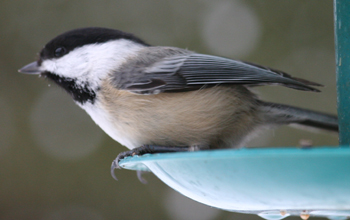Black-capped chickadee
General:
The black-capped chickadee is a familiar visitor to bird feeders in New York. When considering their small size, they seem almost fearless. Many a time I have had a chickadee land right next to me while filling the feeder. I During the fall migration and winter, chickadees often flock together.have been lucky enough to have them eat from my hand.
 The Black-capped Chickadee is very similar to the Carolina Chickadee and where their ranges overlap they can be difficult to separate. In fact, they have trouble telling themselves apart and hybrids occur. The most obvious difference between them is their songs. Black-capped sings a two note song while Carolina sings a four note song. Hybrids sing a three note song. They are the state bird of Maine and Massachusetts.
The Black-capped Chickadee is very similar to the Carolina Chickadee and where their ranges overlap they can be difficult to separate. In fact, they have trouble telling themselves apart and hybrids occur. The most obvious difference between them is their songs. Black-capped sings a two note song while Carolina sings a four note song. Hybrids sing a three note song. They are the state bird of Maine and Massachusetts.
Identification tips:
The black-capped chickadee is approximately 4.5 inches long and has a short bill. It has a black crown and throat with a white face, pale gray upperparts and white edges to wing coverts. Their body has grayish-white underparts and rusty flanks. The sexes similar. They are often found in small flocks
Habitat:
Their breeding habitat is mixe d or deciduous woods in Canada, Alaska and the northern United States. They nest in a hole in a tree; the pair excavates the nest, using a natural cavity or sometimes an old woodpecker nest. They are permanent residents, but sometimes move south within their range in winter.
d or deciduous woods in Canada, Alaska and the northern United States. They nest in a hole in a tree; the pair excavates the nest, using a natural cavity or sometimes an old woodpecker nest. They are permanent residents, but sometimes move south within their range in winter.
Food:
Insects form a large part of their diet, especially in summer; seeds and berries become important in winter. They sometimes hammer seeds on a tree or shrub to open them
Patuxent Bird Identification InfoCenter